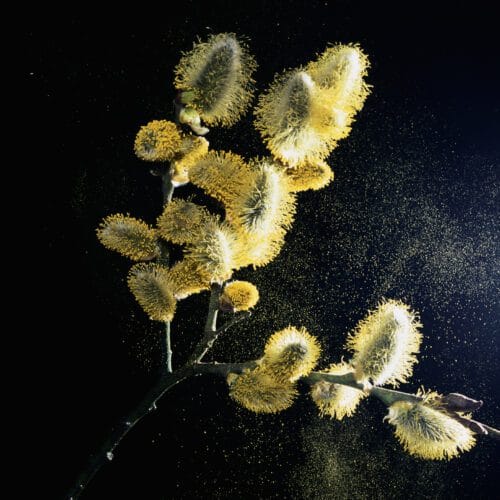
using pollen to make paper sponges and Researchers at Singapore’s Nanyang Technological University are exploring innovative uses for pollen, transforming it into eco-friendly materials like paper and sponges.
using pollen to make paper sponges and
Introduction to Pollen Research
At first glance, Nam-Joon Cho’s laboratory appears to be a conventional research facility, filled with scientists engaged in various experiments, crowded workbenches, and the background hum of machinery. However, a closer inspection reveals a unique focus: the orange-yellow stains on lab coats indicate a less typical subject of study—pollen. This powdery substance, composed of microscopic grains that contain male reproductive cells, is released seasonally by trees, weeds, and grasses. While pollen is often associated with allergies and environmental concerns, Cho’s research takes a different approach, aiming to harness its potential for sustainable materials.
The Science Behind Pollen
Pollen Structure and Composition
Pollen grains are encased in a tough outer shell made of sporopollenin, a polymer renowned for its resilience. This structural integrity has led some scientists to refer to sporopollenin as “the diamond of the plant world.” The robust nature of this polymer makes it an intriguing candidate for various applications beyond its biological role in plant reproduction. Cho’s work focuses on remodeling this rigid structure to create a more malleable form, which he describes as a jam-like consistency. This transformation is crucial, as it allows the pollen to be used in a variety of innovative products.
Transforming Pollen into Microgel
Over the past decade, Cho has dedicated his research to refining techniques that allow for the transformation of pollen grains into a microgel. This process involves breaking down the tough outer shell and altering its properties, making it suitable for a range of applications. The microgel derived from pollen retains many of the beneficial characteristics of the original material while becoming more versatile for use in various eco-friendly products. The transformation process not only enhances the usability of pollen but also maintains its natural benefits, making it an attractive alternative to synthetic materials.
Potential Applications of Pollen Microgel
The implications of this research are vast, as the pollen microgel can serve as a foundational material for several innovative products. Below are some of the most promising applications:
- Paper Production: The microgel can be utilized to create biodegradable paper products, reducing reliance on traditional wood pulp and promoting sustainability in the paper industry. This application is particularly significant given the environmental impact of deforestation and the growing demand for sustainable alternatives.
- Sponges: The unique properties of the microgel make it an excellent candidate for manufacturing sponges that are both absorbent and eco-friendly, potentially replacing synthetic sponges that contribute to plastic waste. This shift could significantly reduce the environmental footprint of household products.
- Films and Coatings: Pollen-derived films could be used in packaging and other applications, providing a biodegradable alternative to conventional plastic films. This could address the pressing issue of plastic pollution, as these films would decompose naturally.
- Biomedical Applications: The biocompatibility of pollen microgel opens avenues for its use in medical applications, such as drug delivery systems or wound dressings. This could lead to advancements in healthcare materials that are both effective and environmentally friendly.
Environmental Implications
The environmental benefits of utilizing pollen as a raw material are significant. Traditional manufacturing processes often rely on non-renewable resources and generate substantial waste. By contrast, using pollen, a naturally occurring substance, could lead to a more sustainable approach to material production. This shift could help mitigate the environmental impact associated with deforestation, plastic pollution, and other ecological concerns.
Reducing Plastic Waste
One of the most pressing environmental issues today is plastic pollution. Single-use plastics contribute to a growing crisis, with millions of tons ending up in landfills and oceans each year. By developing biodegradable alternatives from pollen, researchers like Cho aim to reduce the reliance on plastics and promote a circular economy where materials can be reused and decomposed naturally. This approach not only addresses the immediate problem of plastic waste but also encourages a more sustainable mindset in manufacturing and consumption.
Promoting Biodiversity
Utilizing pollen as a resource also aligns with broader efforts to promote biodiversity. Many plants produce pollen, and tapping into this resource could encourage the cultivation of diverse plant species. This diversification can enhance ecosystems, improve soil health, and support wildlife, contributing to a more balanced environment. By fostering a greater appreciation for the role of plants in our ecosystem, this research could lead to more sustainable agricultural practices and conservation efforts.
Challenges and Considerations
Despite the promising potential of pollen-derived materials, several challenges must be addressed before widespread adoption can occur. These challenges include:
- Scalability: While laboratory experiments have shown success, scaling up production to meet industrial demands poses logistical and technical hurdles. Developing efficient processes for mass production will be crucial for making these materials commercially viable.
- Cost-Effectiveness: The economic feasibility of producing pollen-based materials compared to traditional methods needs thorough evaluation to ensure competitiveness in the market. If the cost of production is too high, it may hinder adoption by manufacturers.
- Public Perception: Overcoming any preconceived notions about pollen and its uses will be essential for consumer acceptance of these new products. Educational initiatives will be necessary to inform the public about the benefits and safety of pollen-derived materials.
Stakeholder Reactions
The research conducted by Cho and his team has garnered interest from various stakeholders, including environmentalists, manufacturers, and policymakers. Many see the potential for pollen-derived materials to contribute to sustainability goals and reduce environmental footprints.
Industry Interest
Manufacturers are particularly intrigued by the prospect of incorporating pollen microgel into their product lines. The demand for sustainable materials is on the rise, and companies are actively seeking alternatives to traditional resources. Pollen’s availability and renewability make it an attractive option for industries looking to enhance their sustainability efforts. As consumers increasingly prioritize eco-friendly products, manufacturers who adopt these innovations may gain a competitive edge in the market.
Environmental Advocacy Groups
Environmental organizations have responded positively to the research, emphasizing the importance of innovative solutions to combat pollution and promote sustainability. They view Cho’s work as a step in the right direction toward reducing plastic waste and fostering a more sustainable future. Advocacy groups are likely to support initiatives that encourage the use of pollen-derived materials, as they align with broader environmental goals.
Government and Policy Implications
Policymakers are also paying attention to the potential of pollen-derived materials. As governments worldwide implement stricter regulations on plastic use and promote sustainable practices, research like Cho’s aligns with these initiatives. Support for such innovations could lead to funding opportunities and incentives for further development. Policymakers may also consider creating frameworks that facilitate the integration of sustainable materials into existing industries.
Future Directions
Looking ahead, Cho and his team plan to continue refining their techniques and exploring additional applications for pollen microgel. Collaborations with industry partners may facilitate the transition from laboratory research to commercial production, allowing for real-world testing and feedback. This collaborative approach could accelerate the development of new products and applications, further enhancing the impact of their research.
Research Expansion
Future research could delve deeper into the properties of pollen microgel, investigating its performance in various applications and its interactions with other materials. Understanding these dynamics will be crucial for optimizing its use and ensuring its effectiveness in different contexts. Additionally, exploring the potential for combining pollen microgel with other sustainable materials could lead to even more innovative products.
Public Awareness and Education
Increasing public awareness about the benefits of pollen-derived materials will also be essential for fostering acceptance. Educational initiatives could help dispel myths about pollen and highlight its potential as a sustainable resource. Engaging with communities and stakeholders will be vital for building support and encouraging the adoption of these innovative products. By promoting a better understanding of the environmental and economic benefits of pollen utilization, researchers can help pave the way for a more sustainable future.
Conclusion
Nam-Joon Cho’s research at Nanyang Technological University represents a significant advancement in the quest for sustainable materials. By transforming pollen into a versatile microgel, Cho is paving the way for eco-friendly alternatives to traditional products, with implications for industries ranging from packaging to healthcare. As the world grapples with environmental challenges, innovations like these offer hope for a more sustainable future, where natural resources are utilized responsibly and effectively. The potential for pollen-derived materials to contribute to a circular economy and promote biodiversity underscores the importance of continued research and collaboration in this field.
Source: Original report
Was this helpful?
Last Modified: September 6, 2025 at 3:59 am
6 views















